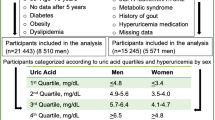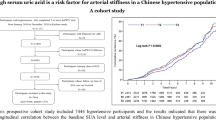Abstract
Although the prevalence of prehypertension is rapidly increasing in China, the medical community has paid little attention to its prevention. Prior studies have demonstrated that uric acid directly contributes to vascular remodelling and endothelial dysfunction. However, few prospective studies have assessed the relationship between serum uric acid and prehypertension. We therefore designed a larger-scale cohort study to examine whether uric acid level is a predictive factor for developing prehypertension in adults. Participants were recruited from Tianjin Medical University General Hospital-Health Management Centre. A prospective assessment (n=15 143) was performed. Participants without a history of hypertension or prehypertension were followed up for 2 to 6 years with a median follow-up duration of 2.8 years. Serum uric acid levels and blood pressure were assessed yearly during the follow-up. Adjusted Cox proportional hazards regression models were used to assess relationships between the quintiles of uric acid levels and the incidence of prehypertension. The incidence of prehypertension was 191 per 1000 person-years. In the final multivariate models, the hazard ratios (95% confidence interval) for prehypertension across uric acid quintiles were 1.00 (reference), 0.98 (0.90–1.07), 1.01 (0.93–1.10), 1.09 (1.001–1.20) and 1.17 (1.06–1.29) (P for trend <0.001), respectively. This population-based prospective cohort study has demonstrated that uric acid level is an independent predictor for developing prehypertension.
This is a preview of subscription content, access via your institution
Access options
Subscribe to this journal
Receive 12 digital issues and online access to articles
$119.00 per year
only $9.92 per issue
Buy this article
- Purchase on Springer Link
- Instant access to full article PDF
Prices may be subject to local taxes which are calculated during checkout


Similar content being viewed by others

References
Chobanian AV, Bakris GL, Black HR, Cushman WC, Green LA, Izzo JL Jr et al. The Seventh Report of the Joint National Committee on Prevention, Detection, Evaluation, and Treatment of High Blood Pressure: the JNC 7 report. JAMA 2003; 289 (19): 2560–2572.
Meng XJ, Dong GH, Wang D, Liu MM, Liu YQ, Zhao Y et al. Epidemiology of prehypertension and associated risk factors in urban adults from 33 communities in China—HPSNE study. Circ J 2012; 76 (4): 900–906.
Yu D, Huang J, Hu D, Chen J, Cao J, Li J et al. Prevalence and risk factors of prehypertension among Chinese adults. J Cardiovasc Pharmacol 2008; 52 (4): 363–368.
Vasan RS, Larson MG, Leip EP, Evans JC, O’Donnell CJ, Kannel WB et al. Impact of high-normal blood pressure on the risk of cardiovascular disease. N Engl J Med 2001; 345 (18): 1291–1297.
Ishikawa Y, Ishikawa J, Ishikawa S, Kajii E, Schwartz JE, Pickering TG et al. Prehypertension and the risk for cardiovascular disease in the Japanese general population: the Jichi Medical School Cohort Study. J Hypertens 2010; 28 (8): 1630–1637.
Sit JW, Sijian L, Wong EM, Yanling Z, Ziping W, Jianqiang J et al. Prevalence and risk factors associated with prehypertension: identification of foci for primary prevention of hypertension. J Cardiovasc Nurs 2010; 25 (6): 461–469.
Perlstein TS, Gumieniak O, Hopkins PN, Murphey LJ, Brown NJ, Williams GH et al. Uric acid and the state of the intrarenal renin-angiotensin system in humans. Kidney Int 2004; 66 (4): 1465–1470.
Kang DH, Park SK, Lee IK, Johnson RJ . Uric acid-induced C-reactive protein expression: implication on cell proliferation and nitric oxide production of human vascular cells. J Am Soc Nephrol 2005; 16 (12): 3553–3562.
Khosla UM, Zharikov S, Finch JL, Nakagawa T, Roncal C, Mu W et al. Hyperuricemia induces endothelial dysfunction. Kidney Int 2005; 67 (5): 1739–1742.
Whelton A . Hyperuricemia and hypertension: a confluence of concepts. Hypertension 2012; 60 (5): 1112–1113.
Hayden MR, Tyagi SC . Uric acid: a new look at an old risk marker for cardiovascular disease, metabolic syndrome, and type 2 diabetes mellitus: the urate redox shuttle. Nutr Metab 2004; 1 (1): 10.
Glowinska B, Urban M . Selected cytokines (Il-6, Il-8, Il-10, MCP-1, TNF-alpha) in children and adolescents with atherosclerosis risk factors: obesity, hypertension, diabetes. Wiad Lek 2003; 56 (3–4): 109–116.
Syamala S, Li J, Shankar A . Association between serum uric acid and prehypertension among US adults. J Hypertens 2007; 25 (8): 1583–1589.
Liang J, Xue Y, Zou C, Zhang T, Song H, Qi L . Serum uric acid and prehypertension among Chinese adults. J Hypertens 2009; 27 (9): 1761–1765.
Soletsky B, Feig DI . Uric acid reduction rectifies prehypertension in obese adolescents. Hypertension 2012; 60 (5): 1148–1156.
Song K, Du H, Zhang Q, Wang C, Guo Y, Wu H et al. Serum immunoglobulin M concentration is positively related to metabolic syndrome in an adult population: Tianjin Chronic Low-Grade Systemic Inflammation and Health (TCLSIH) Cohort Study. PLoS ONE 2014; 9 (2): e88701.
Yu B, He H, Zhang Q, Wu H, Du H, Liu L et al. Soft drink consumption is associated with depressive symptoms among adults in China. J Affect Disord 2015; 172: 422–427.
Sun S, Wu H, Zhang Q, Wang C, Guo Y, Du H et al. Subnormal peripheral blood leukocyte counts are related to the lowest prevalence and incidence of metabolic syndrome: Tianjin chronic low-grade systemic inflammation and health cohort study. Mediators Inflamm 2014; 2014: 412386.
Jossa F, Farinaro E, Panico S, Krogh V, Celentano E, Galasso R et al. Serum uric acid and hypertension: the Olivetti heart study. J Hum Hypertens 1994; 8 (9): 677–681.
Zhang W, Sun K, Yang Y, Zhang H, Hu FB, Hui R . Plasma uric acid and hypertension in a Chinese community: prospective study and metaanalysis. Clin Chem 2009; 55 (11): 2026–2034.
Yang T, Chu CH, Bai CH, You SL, Chou YC, Hwang LC et al. Uric acid concentration as a risk marker for blood pressure progression and incident hypertension: a Chinese cohort study. Metabolism 2012; 61 (12): 1747–1755.
Nagahama K, Inoue T, Kohagura K, Kinjo K, Ohya Y . Associations between serum uric acid levels and the incidence of hypertension and metabolic syndrome: a 4-year follow-up study of a large screened cohort in Okinawa, Japan. Hypertens Res 2015; 38 (3): 213–218.
Vucak J, Katic M, Bielen I, Vrdoljak D, Lalic DI, Kranjcevic K et al. Association between hyperuricemia, prediabetes, and prehypertension in the Croatian adult population—- cross-sectional study. BMC Cardiovasc Disord 2012; 12: 117.
Feig DI . The role of uric acid in the pathogenesis of hypertension in the young. J Clin Hypertens 2012; 14 (6): 346–352.
Sundstrom J, Sullivan L, D’Agostino RB, Levy D, Kannel WB, Vasan RS . Relations of serum uric acid to longitudinal blood pressure tracking and hypertension incidence. Hypertension 2005; 45 (1): 28–33.
Peng H, Ding J, Peng Y, Zhang Q, Xu Y, Chao X et al. Hyperuricemia and microalbuminuria are separately and independently associated with prehypertension among Chinese Han women. Metab Syndr Relat Disord 2012; 10 (3): 202–208.
Bao X, Wang Q, Chen G, Wang Q, Liang R, Zhang S . Serum concentration of uric acid associated with prehypertension among Chinese population. Angiology 2014; 65 (9): 800–805.
Liu PW, Chang TY, Chen JD . Serum uric acid and metabolic syndrome in Taiwanese adults. Metabolism 2010; 59 (6): 802–807.
Rao GN, Corson MA, Berk BC . Uric acid stimulates vascular smooth muscle cell proliferation by increasing platelet-derived growth factor A-chain expression. J Biol Chem 1991; 266 (13): 8604–8608.
Eraranta A, Kurra V, Tahvanainen AM, Vehmas TI, Koobi P, Lakkisto P et al. Oxonic acid-induced hyperuricemia elevates plasma aldosterone in experimental renal insufficiency. J Hypertens 2008; 26 (8): 1661–1668.
Mazzali M, Hughes J, Kim YG, Jefferson JA, Kang DH, Gordon KL et al. Elevated uric acid increases blood pressure in the rat by a novel crystal-independent mechanism. Hypertension 2001; 38 (5): 1101–1106.
Klein BE, Klein R, Lee KE . Components of the metabolic syndrome and risk of cardiovascular disease and diabetes in Beaver Dam. Diabetes Care 2002; 25 (10): 1790–1794.
Viazzi F, Garneri D, Leoncini G, Gonnella A, Muiesan ML, Ambrosioni E et al. Serum uric acid and its relationship with metabolic syndrome and cardiovascular risk profile in patients with hypertension: insights from the I-DEMAND study. Nutr Metab Cardiovasc Dis 2014; 24 (8): 921–927.
Johnson RJ, Sanchez-Lozada LG, Mazzali M, Feig DI, Kanbay M, Sautin YY . What are the key arguments against uric acid as a true risk factor for hypertension? Hypertension 2013; 61 (5): 948–951.
dabl®EducationalTrust. http://www.dableducational.org/sphygmomanometers/devices_1_clinical.html #ClinTable, accessed 21 March 2016.
Acknowledgements
We gratefully acknowledge the participants of the study and Tianjin Medical University General Hospital-Health Management Center for the possibility to perform the study. This study was supported by grants from the key technologies R&D program of Tianjin (Key Project: Nos. 11ZCGYSY05700, 12ZCZDSY20400, and 13ZCZDSY20200), the National Science and Technology Support Program (No. 2012BAI02B02), 2012 Chinese Nutrition Society (CNS) Nutrition Research Foundation—DSM Research Fund (No. 2014–071), the National Natural Science Foundation of China (Nos. 81372118, 81372467 and 81302422), the Technologies development program of Beichen District of Tianjin (Nos. bcws2013–21 and bc2014–05), the technologies project of Tianjin Binhai New Area (Nos. 2013-02-04 and 2013-02-06), the Science Foundation of Tianjin Medical University (Nos. 2010KY28 and 2013KYQ24), the Key Laboratory of Public Health Safety (Fudan University), Ministry of Education (No. GW2014-5), and the National Training Programs of Innovation and Entrepreneurship for Undergraduates (No. 201510062013), China.
Author information
Authors and Affiliations
Corresponding author
Ethics declarations
Competing interests
The authors declare no conflict of interest.
Rights and permissions
About this article
Cite this article
Liu, L., Gu, Y., Li, C. et al. Serum uric acid is an independent predictor for developing prehypertension: a population-based prospective cohort study. J Hum Hypertens 31, 116–120 (2017). https://doi.org/10.1038/jhh.2016.48
Received:
Revised:
Accepted:
Published:
Issue Date:
DOI: https://doi.org/10.1038/jhh.2016.48
This article is cited by
-
Baseline and change in serum uric acid predict the progression from prehypertension to hypertension: a prospective cohort study
Journal of Human Hypertension (2022)
-
The effect of uric acid and urinary sodium excretion on prehypertension: a nationwide population-based study
BMC Cardiovascular Disorders (2020)
-
Hyperuricemia and Risk of Cardiovascular Outcomes: The Experience of the URRAH (Uric Acid Right for Heart Health) Project
High Blood Pressure & Cardiovascular Prevention (2020)
-
Association between urinary sodium excretion and uric acid, and its interaction on the risk of prehypertension among Chinese young adults
Scientific Reports (2018)
-
Relationship of serum immunoglobulin levels to blood pressure and hypertension in an adult population
Journal of Human Hypertension (2018)


